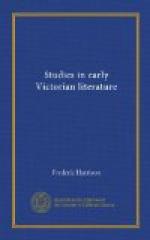The list of Trollope’s real successes is not very long. The six tales of the Barsetshire cycle, The Warden, Barchester Towers, Doctor Thorne, Framley Parsonage, The Small House at Allington, The Last Chronicle of Barset, are unquestionably his main achievements; and of these either Doctor Thorne or The Last Chronicle is the best. The Crawley story is undoubtedly the finest thing Trollope ever did; but for myself, I enjoy the unity, completeness, and masterly scheme of Doctor Thorne, and I like Mary Thorne better than any of Trollope’s women. If, to the six Barset tales, we add Orley Farm, The Claverings, the two Phineas Finns, and the Eustace Diamonds, we shall include, perhaps, more than posterity will ever trouble itself about, and almost exactly one-fifth of the novels he left behind. The ten or twelve of Trollope’s best will continue to be read, and will, in a future generation, no doubt, regain not a little of their early vogue. This will be due, in part, to their own inherent merit as graceful, truthful, subtle observation of contemporary types, clothed in a style of transparent ease. Partly, it will be due to this: that these tales will reproduce for the future certain phases of life in the nineteenth century in England with minute fidelity and the most literal realism.
This is no doubt the cause of the revulsion of opinion by which in some English circles Trollope has suffered of late. If there are fashions, habits, and tastes which the rising generation is certain to despise, it is such as were current in the youth of their own parents about thirty or forty years before them. The collars, the bonnets, the furniture, the etiquette, the books of that age always seem to the young to be the last word of all that is awkward and “bad form,” although in two or three generations these very modes regain a certain quaint charm. And for the moment poor Anthony represents to the emancipated youth of our time all that was “banal” and prosy some thirty years ago. The taste of our youth sets hard for a new heaven, or at least a new earth, and if not that, it may be a new hell. Novels or poems without conundrums, without psychologic problems, with no sexual theorems to solve, with no unique idiosyncrasies to fathom, without anything unnatural, or sickening, without hospital nastinesses,—are all, we are assured, unworthy the notice of the youth of either sex who are really up to date. In the style of the new pornographic and clinical school of art, the sayings and doings of wholesome men and women who live in drawing-rooms and regularly dress before dinner are “beastly rot,” and fit for no one but children and old maids.




